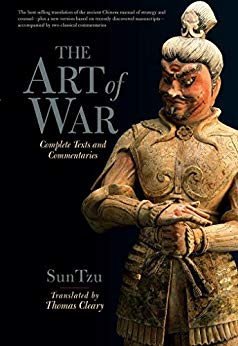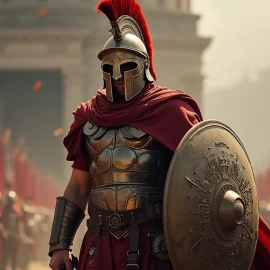

This article is an excerpt from the Shortform summary of "The Art of War" by Sun Tzu. Shortform has the world's best summaries of books you should be reading.
Like this article? Sign up for a free trial here .
Who was Sun Tzu? What’s the key premise of Sun Tzu’s philosophy?
In The Art of War, Sun Tzu, a Chinese warrior and philosopher, details the nature of competition and psychology of leadership and provides strategies for how to approach both. Although Sun Tzu’s principles are geared toward actual military conflict, they can be useful in all areas of conflict or competition, even at a personal level.
Keep reading for Sun Tzu’s principles of war and the rationale behind them.
Sun Tzu: The Art of War
Written more than two thousand years ago, The Art of War by Sun Tzu is a renowned guide for how to engage in conflict and be successful in battle.
Sun Tzu’s principles of war revolve around the concept that victory without direct fighting is the most advantageous way to win. Part of attaining this type of battle-free victory involves five traits or principles of successful military operations: the Way, the weather, the terrain, the leadership, and discipline.
Principle #1: The Way
The Way describes the harmonious relationship between the government and civilian populace. When governments treat their people fairly and with respect, the people will be loyal and more apt to support government decisions when conflict arises. People will also be more willing to join in the conflict if they believe in the government they will be tasked to defend.
Principle #2: The Weather
The weather means the literal seasons and conditions of whatever environment in which the battle will be waged. Certain weather conditions are not conducive for a military campaign. For instance, both winter and summer encompass dangerous conditions, such as blizzards or droughts, that can hinder the advancement, safety, health, and sustenance of a troop.
Principle #3: The Terrain
The terrain relates to the “lay of the land,” meaning the geographical and physical factors of certain types of terrain. These factors make a parcel of land either advantageous or disadvantageous for advancement or battle. Factors to consider include distance to be traveled, the layout of the terrain and accompanying effort required to cross it, the size of the land, and safety and dangers encompassed in the geography.
Principle #4: The Leadership
The leadership describes the acuity and competence of the person charged with leading a fighting force. A good leader should be intelligent, trustworthy, humane, courageous, and stern. When all of these factors are at play, the leader is capable of making sound decisions and can count on the people to support them.
Principle #5: Discipline
Discipline relates to the structure and organization of the personnel hierarchy. Determining who is best suited for high-ranking roles, who is capable of being brave, and who is weaker than the others is as important in determining a strong strategy as supplies are for the health of the troops.
You should consider how these five principles affect both your side and your opponent. Only in knowing both your strengths and weaknesses, as well as those of the enemy, can you begin to form a strategic plan. When you understand these principles, you will be able to assess the likelihood of victory in any circumstance. If victory is not certain, you should not engage in conflict.
Advance Only If Advantage Is on Your Side
First, you should assess these five traits regarding your forces. Then, assess these five traits for your opponent to size up the competition.
- If you understand both your strengths and efficiency and those of your enemy, you can realistically compare the two and predict the likelihood of victory during conflicts.
- You should prepare to enter into conflict only when the outcome shows the likelihood of success for your side.
Advantages in Battle Strategy
Strategy should be developed as a consequence of advantage. A course of action that is not pliable will fail because the strategy cannot adapt to new events. A leader must assess each event that occurs and take advice to see where subsequent advantages lie and proceed accordingly.
Battle strategies covered by Sun Tzu include deception, reading the enemy, wearing the enemy down, and using spies.
Deception
The goal of any conflict is to control your opponent and overcome them. Controlling their beliefs about your abilities helps you understand their assumptions and plan a strategy accordingly. As a well-known translation of Sun Tzu puts it, “all warfare is based on deception.”
Deception includes feigning weakness when you are strong or professing ignorance when you are informed. Appearing to be weak, unprepared, or small in size can lure your opponent into traps and make them susceptible to misguided actions or responses.
For instance, creating a scenario where only a small portion of your force is visible can mislead opponents into thinking they outnumber or outarm you. When they prepare an attack under that guise, they will be ill-prepared for the full strength of your forces.
Another example is allowing your opponent to win small victories or gains. Your opponent may fall victim to greed or an inflated ego, which will confuse and hinder their strategy when the truth is revealed.
Reading the Enemy
As stated, knowing the strength of your opponent is vital. Once you have fully assessed your opponent’s capabilities, you must understand how to use the information to bolster your position.
If the enemy is operating from a foundation of fullness, meaning all facets of the five traits are viable, you should keep a close eye on them and start organizing your forces. Ensure that your side is equally “fulfilled” and aware of possible conflict. Avoid conflict until your enemy’s situation changes.
- When your opponent sees that you mean not to engage in the conflict, a gap may open up. They may relax and provide an opportunity suitable for attack.
- Also, your lack of action may begin to anger the opposing leadership.
- Continue to find ways to anger and irritate your opponent, for decisions made out of anger are often petulant and rash, which can lead to advantages for you.
Once you notice that your opponent is riled up or angry, back off to give them the delusion of superiority or success. They may become arrogant or lax in their judgment, from which carelessness extends.
- If the enemy deems that you are no longer a threat, they will underestimate you or dismiss you as an opponent.
- This arrogance creates the perfect environment for you to successfully attack them.
Wearing the Enemy Down
In addition to manipulating a strong enemy into carelessness, forcing the enemy to exert energy will create opportunities of advantage for you.
Strategize your efforts so they are geared toward controlling your opponent’s momentum. These tactics include surprise attacks, retreating when they advance, advancing when they retreat, and maneuvering them in different directions.
For example, you might strike a certain portion of the enemy’s forces to push them down a particular path in defense. When their energy shifts to take up this defense, switch your assault to the enemy troops in the opposite direction. Switching attack positions forces your opponent’s defense to hustle down another path to defend against your advance.
Moving them back and forth by forcing them to react to conflict, rather than allowing them to initiate conflict, will keep them on their toes and tire them out.
Using Spies and Aggravators
Since no strategy is complete without assessing the enemy, one of the most important aspects of any conflict is the use of spies.
Send someone to infiltrate the enemy’s ranks to create discord. These spies can create rifts between the soldiers and leaders or among individual ranks through false information.
If members of the opponent’s team begin to distrust the leadership or covet the spoils they enjoy, harmony among the ranks will be destroyed. When there is disunity in your opponent’s ranks, you have gained an advantage.
Likewise, treating the enemy’s populace better than the enemy treats them can swing loyalties and create division. Dissension can also be created between the enemy and their allies, which divides their sources of power.
When the enemy is distracted or distressed by this division, attack.
———End of Preview———

Like what you just read? Read the rest of the world's best summary of "The Art of War" at Shortform . Learn the book's critical concepts in 20 minutes or less .
Here's what you'll find in our full The Art of War summary :
- How to mislead your enemies to win the war
- Classic examples from Chinese history to illustrate Sun Tzu's strategies
- How to use spies to gather information and defeat your opponents






